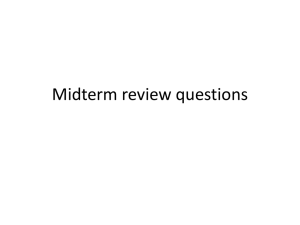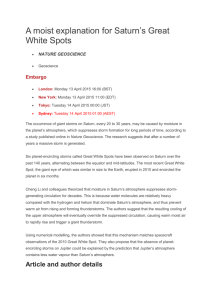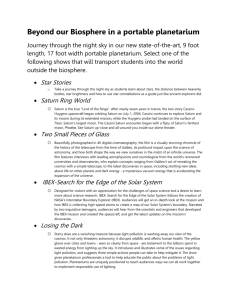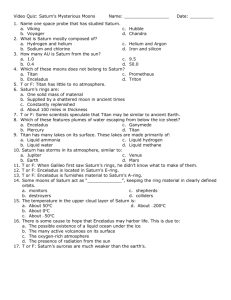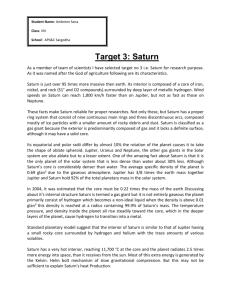Orbital parameters
advertisement
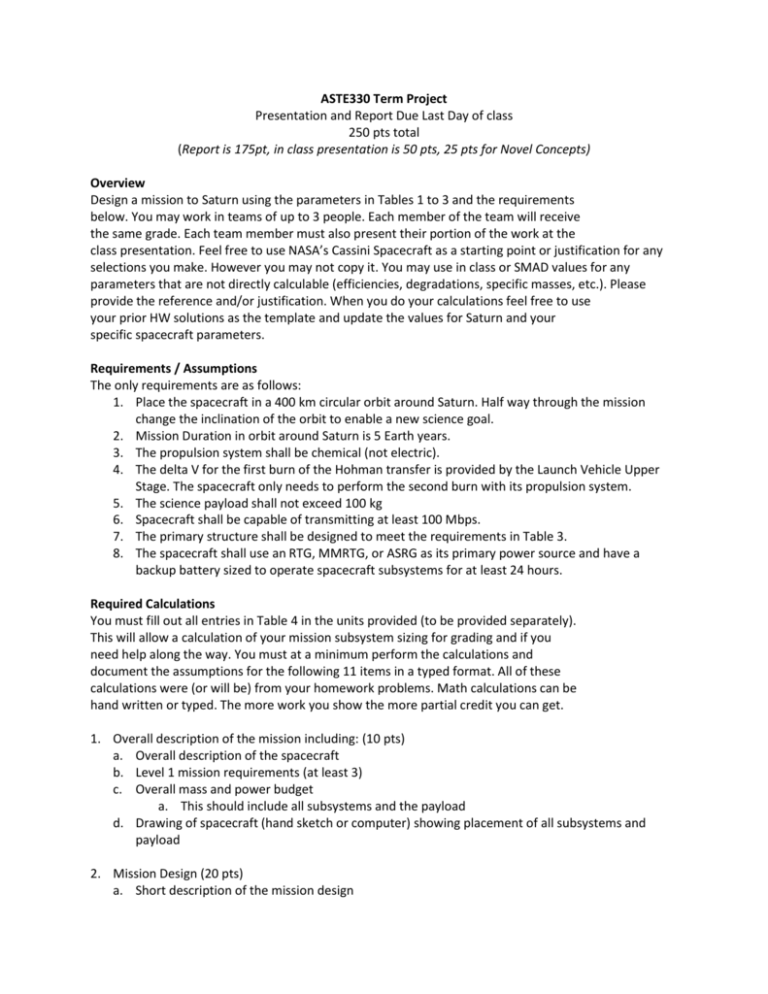
ASTE330 Term Project Presentation and Report Due Last Day of class 250 pts total (Report is 175pt, in class presentation is 50 pts, 25 pts for Novel Concepts) Overview Design a mission to Saturn using the parameters in Tables 1 to 3 and the requirements below. You may work in teams of up to 3 people. Each member of the team will receive the same grade. Each team member must also present their portion of the work at the class presentation. Feel free to use NASA’s Cassini Spacecraft as a starting point or justification for any selections you make. However you may not copy it. You may use in class or SMAD values for any parameters that are not directly calculable (efficiencies, degradations, specific masses, etc.). Please provide the reference and/or justification. When you do your calculations feel free to use your prior HW solutions as the template and update the values for Saturn and your specific spacecraft parameters. Requirements / Assumptions The only requirements are as follows: 1. Place the spacecraft in a 400 km circular orbit around Saturn. Half way through the mission change the inclination of the orbit to enable a new science goal. 2. Mission Duration in orbit around Saturn is 5 Earth years. 3. The propulsion system shall be chemical (not electric). 4. The delta V for the first burn of the Hohman transfer is provided by the Launch Vehicle Upper Stage. The spacecraft only needs to perform the second burn with its propulsion system. 5. The science payload shall not exceed 100 kg 6. Spacecraft shall be capable of transmitting at least 100 Mbps. 7. The primary structure shall be designed to meet the requirements in Table 3. 8. The spacecraft shall use an RTG, MMRTG, or ASRG as its primary power source and have a backup battery sized to operate spacecraft subsystems for at least 24 hours. Required Calculations You must fill out all entries in Table 4 in the units provided (to be provided separately). This will allow a calculation of your mission subsystem sizing for grading and if you need help along the way. You must at a minimum perform the calculations and document the assumptions for the following 11 items in a typed format. All of these calculations were (or will be) from your homework problems. Math calculations can be hand written or typed. The more work you show the more partial credit you can get. 1. Overall description of the mission including: (10 pts) a. Overall description of the spacecraft b. Level 1 mission requirements (at least 3) c. Overall mass and power budget a. This should include all subsystems and the payload d. Drawing of spacecraft (hand sketch or computer) showing placement of all subsystems and payload 2. Mission Design (20 pts) a. Short description of the mission design b. c. d. e. f. g. Hohman transfer from Earth to Saturn Trip time to destination Maximum distance from sun (defines minimum power generation) Maximum distance from Earth versus (defines maximum space loss) Thermal heat flux environment over an orbit (solar, IR, albedo) Propellant budget calculation (after you have done parts 3 and 4) 3. Chemical Propulsion Subsystem (20 pts) a. Type of thruster and propellant you selected b. Define To and Po c. Nozzle area ratio calculation or selection d. Exit pressure and Mach number calculation e. Mass flow rate calculation f. Specific Impulse calculation g. Thrust calculation (Pa=0 but you still need to calculate Pe*Ae term) h. Propellant Mass for cruise i. Propellant Mass for ACS (if primary ACS or for momentum wheel dumping) j. Main engine burn time only for major maneuvers 4. ADCS Subsystem (20 pts) a. Short description of the subsystem you selected including hardware for attitude determination and control b. Choose spin or three axis stabilized c. Calculate disturbance torques and size the system accordingly (see Table 1 for Saturn specifics) d. Mass and power estimate for the ADCS (you may use SMAD or numbers from other representative spacecraft) 5. C&DH Subsystem (10 pts) a. Define mass, power, volume based on complexity (SMAD table) 6. Power Subsystem a. Short description of the subsystem you selected b. Calculate solar irradiance, albedo, and IR components of q_ext at Saturn. The hot and cold case are related to distance from the sun for solar and albedo. c. Size RTG for operation at Saturn (mass, BOL and EOL power). a. Determine EOL performance on orbit b. Determine battery size and type of battery c. Determine mass of the array and battery 7. Thermal Subsystem (20 pts) a. Short description of the subsystem you selected b. Determine the allowable flight temperature range c. Calculate solar irradiance, albedo, and IR components of q_ext at Saturn. For the cold case assume you are in the eclipse period. d. Size the radiator for worst case hot e. Size the survival heaters for worst case cold 8. Primary Structure Subsystem design using the provided launch vehicle parameters (Table 3). Use Aluminum for the primary structure material. It is fine to use an evenly distributed mass assumption but the placement of the various hardware should be consistent with that. a. Short description of the subsystem you selected (including shape) b. Load calculations for ultimate stress, yield stress, buckling stress, and f. natural frequency c. State Shape and AMOI d. Discuss placement subsystems within the overall spacecraft 9. Payload subsystem a. Define at least three science instruments including their mass, power, and data rate (feel free to use instruments from other missions) b. Define one scientific objective for each instrument. 10. Telecommunications system a. Short description of the subsystem you selected b. Frequency Band c. Antenna size, type, efficiency d. Transmitter power e. Maximum payload data rate (from part 9) f. House keeping data rate g. Link Budget for maximum distance from Earth 11. Description of the sensitivities of the space craft to the space environment around Saturn a. Calculate the total radiation dose based on the thickness of your structure a. (assuming Al) b. Calculate flux of MM versus particle size c. Design choices you have made to mitigate spacecraft charging d. Brief discussion of materials that you have selected and how that may e. affect contamination, radiation degradation, thermal performance, etc. Table 3. Atlas V Class Launch Vehicle Parameters Lateral Natural Frequency (Hz) 8 Axial Natural Frequency (Hz) 15 Axial Load Factor 7 Lateral Load Factor 3 Maximum Fairing Diameter (m) 4 Maximum Fairing length (m) 10 More info on Saturn here. http://nssdc.gsfc.nasa.gov/planetary/factsheet/saturnfact.html More info on the launch vehicle here. http://www.spacelaunchreport.com/atlas5.html Saturn Bulk parameters Saturn Earth Ratio (Saturn/Earth) Mass (1024 kg) 568.36 5.9726 95.159 Volume (1010 km3) 82,713 108.321 763.59 Radius (1 bar level) (km) Equatorial 60,268 6,378.1 9.449 Polar 54,364 6,356.8 8.552 Volumetric mean radius (km) 58,232 6,371.0 9.140 Ellipticity (Flattening) 0.09796 0.00335 29.24 Mean density (kg/m3) 687 5,514 0.125 Gravity (eq., 1 bar) (m/s2) 10.44 9.80 1.065 Acceleration (eq., 1 bar) (m/s2) 8.96 9.78 0.916 Escape velocity (km/s) 35.5 11.19 3.172 GM (x 106 km3/s2) 37.931 0.3986 95.16 Bond albedo 0.342 0.306 1.12 Visual geometric albedo 0.47 0.367 1.28 Visual magnitude V(1,0) -8.88 -3.86 Solar irradiance (W/m2) 14.90 1,367.6 0.011 Black-body temperature (K) 81.1 254.3 0.319 Moment of inertia (I/MR2) 0.210 0.3308 0.635 J2 (x 10-6) 16,298. 1082.63 15.054 Number of natural satellites 62 1 Planetary ring system Yes No Orbital parameters Semimajor axis (106 km) Sidereal orbit period (days) Tropical orbit period (days) Perihelion (106 km) Aphelion (106 km) Synodic period (days) Mean orbital velocity (km/s) Max. orbital velocity (km/s) Min. orbital velocity (km/s) Orbit inclination (deg) Orbit eccentricity Sidereal rotation period (hours) Length of day (hrs) Obliquity to orbit (deg) Saturn 1,433.53 10,759.22 10,746.94 1,352.55 1,514.50 378.09 9.68 10.18 9.09 2.485 0.0565 10.656* 10.656 26.73 Earth Ratio (Saturn/Earth) 149.60 9.582 365.256 29.457 365.242 29.424 147.09 9.195 152.10 9.957 29.78 0.325 30.29 0.336 29.29 0.310 0.000 0.0167 3.383 23.9345 0.445 24.0000 0.444 23.44 1.140 Saturn Observational Parameters Distance from Earth Minimum (106 km) 1195.5 Maximum (106 km) 1658.5 Apparent diameter from Earth Maximum (seconds of arc) 20.1 Minimum (seconds of arc) 14.5 Mean values at opposition from Earth Distance from Earth (106 km) 1277.42

